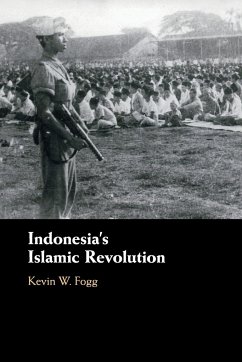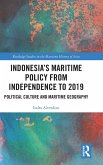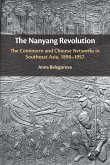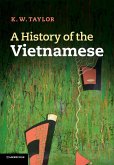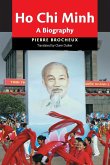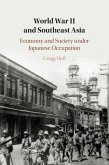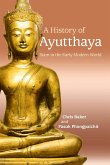Kevin W. Fogg (University of Oxford)
Indonesia's Islamic Revolution
Kevin W. Fogg (University of Oxford)
Indonesia's Islamic Revolution
- Broschiertes Buch
- Merkliste
- Auf die Merkliste
- Bewerten Bewerten
- Teilen
- Produkt teilen
- Produkterinnerung
- Produkterinnerung
The decolonization of Indonesia, the world's most populous Muslim country, was seen by up to half of the population as a religious struggle. Utilizing a combination of oral history and archival research, Kevin W. Fogg presents a new understanding of the Indonesian revolution and of Islam as a revolutionary ideology.
Andere Kunden interessierten sich auch für
![Indonesia's Maritime Policy from Independence to 2019 Indonesia's Maritime Policy from Independence to 2019]() Indra AlverdianIndonesia's Maritime Policy from Independence to 2019143,99 €
Indra AlverdianIndonesia's Maritime Policy from Independence to 2019143,99 €![The Nanyang Revolution The Nanyang Revolution]() Anna Belogurova (Freie Universitat Berlin)The Nanyang Revolution38,99 €
Anna Belogurova (Freie Universitat Berlin)The Nanyang Revolution38,99 €![A History of the Vietnamese A History of the Vietnamese]() K. W. Taylor (New York Cornell University)A History of the Vietnamese56,99 €
K. W. Taylor (New York Cornell University)A History of the Vietnamese56,99 €![Ho Chi Minh Ho Chi Minh]() Pierre Brocheux (Universite de Paris VII (Denis Diderot) )Ho Chi Minh36,99 €
Pierre Brocheux (Universite de Paris VII (Denis Diderot) )Ho Chi Minh36,99 €![World War II and Southeast Asia World War II and Southeast Asia]() Gregg Huff (University of Oxford)World War II and Southeast Asia56,99 €
Gregg Huff (University of Oxford)World War II and Southeast Asia56,99 €![A History of Ayutthaya A History of Ayutthaya]() Chris BakerA History of Ayutthaya39,99 €
Chris BakerA History of Ayutthaya39,99 €![The Third Indochina War The Third Indochina War]() Cheng Guan Ang (Singapore Nanyang Technological University)The Third Indochina War35,99 €
Cheng Guan Ang (Singapore Nanyang Technological University)The Third Indochina War35,99 €-
-
-
The decolonization of Indonesia, the world's most populous Muslim country, was seen by up to half of the population as a religious struggle. Utilizing a combination of oral history and archival research, Kevin W. Fogg presents a new understanding of the Indonesian revolution and of Islam as a revolutionary ideology.
Hinweis: Dieser Artikel kann nur an eine deutsche Lieferadresse ausgeliefert werden.
Hinweis: Dieser Artikel kann nur an eine deutsche Lieferadresse ausgeliefert werden.
Produktdetails
- Produktdetails
- Verlag: Cambridge University Press
- Seitenzahl: 272
- Erscheinungstermin: 20. Oktober 2022
- Englisch
- Abmessung: 229mm x 152mm x 15mm
- Gewicht: 412g
- ISBN-13: 9781108738170
- ISBN-10: 1108738176
- Artikelnr.: 64364637
- Herstellerkennzeichnung
- Libri GmbH
- Europaallee 1
- 36244 Bad Hersfeld
- gpsr@libri.de
- Verlag: Cambridge University Press
- Seitenzahl: 272
- Erscheinungstermin: 20. Oktober 2022
- Englisch
- Abmessung: 229mm x 152mm x 15mm
- Gewicht: 412g
- ISBN-13: 9781108738170
- ISBN-10: 1108738176
- Artikelnr.: 64364637
- Herstellerkennzeichnung
- Libri GmbH
- Europaallee 1
- 36244 Bad Hersfeld
- gpsr@libri.de
Kevin W. Fogg is a research associate at the Oxford Centre for Global History and Brasenose College, University of Oxford.
Introduction
1. Islam in Indonesia before the Revolution
1.1 Islam in Indonesia at the turn of the twentieth century
1.2 Divisions within the Muslim community
1.3 Trends in the early twentieth century
1.4 Japanese occupation
Part I. Islam in Indonesia's War of Independence: 2. Islamic calls to action
2.1 The reasons for the revolutionary struggle
2.2 Early Fatwas
2.3 A flood of Fatwas
2.4 A manifesto for the Islamic revolution: M. Arsjad Thalib Lubis's Toentoenan Perang Sabil
2.5 Attacks on Islam as calls for action
2.6 Conclusion
3. Ulama, Islamic organizations, and Islamic militias
3.1 Ulama as revolutionary leaders
3.2 The mobilization of Islamic organizations
3.3 Sabilillah and Hizbullah
3.4 Islamic militias in battle
3.5 Conclusion
4. Magic, amulets and trances
4.1 Tradition of Islamic magic
4.2 Prayers and incantations
4.3 Amulets and spells
4.4 Martial arts and trances
4.5 Consequences of Islamic magic: fearlessness and high casualties
4.6 Conclusions
5. Social revolution
5.1 Meaning of social revolution
5.2 Out with the old
5.3 In with the new (and Islamic)
5.4 Social revolution in Aceh: the Cumbok War
5.5 Madiun affair as competing social revolutions
5.6 Staying power of social revolution
5.7 Conclusion
6. Darul Islam
6.1 Sequence of events leading Kartosuwirjo into rebellion
6.2 The Darul Islam movement within the Islamic spectrum
6.3 Exceptional factor: Kartosuwirjo
6.4 Conclusion
Part II. Islam in Indonesia's Political Revolution: 7. The Jakarta Charter controversy
7.1 Creation of the investigatory board
7.2 The creation of Pancasila and the Jakarta Charter
7.3 Removal of the Jakarta charter from the constitution
7.4 Implications of the elimination of the Jakarta Charter
8. The creation of Masjumi
8.1 The evolving state in 1945
8.2 Founding an Islamic political party: Masjumi
8.3 Extraordinary members
8.4 Masjumi leadership in 1945
8.5 Conclusions
9. The ministry of religion
9.1 Colonial precedents
9.2 Establishing a ministry
9.3 The ministry of religion in action
9.4 Conclusions: importance of the ministry
10. Rise of Islamic socialists
10.1 Background of the Islamic socialists
10.2 Rise in government and the party
10.3 Islamic socialists and the Masjumi platform
10.4 Conclusions
11. Regional Islamic parties
11.1 Masjumi's geographic expansion
11.2 Persatuan Tarbiyah Islamiyah (Perti)
11.3 Regional political Islam facing federalism
11.4 Conclusion
12. The exit of PSII and the first fracture of Masjumi
12.1 Standard narrative of PSII's exit: central power play
12.2 PSII's own narrative: regional initiative
12.3 Weighing personal versus regional interests in PSII's rebirth
12.4 Conclusions: the implications of PSII's exit for Islamic politics
13. Islamic diplomacy
13.1 Grassroots Islamic diplomacy
13.2 Success with the Arab League
13.3 Diplomatic milestones
13.4 Conclusions
Conclusion.
1. Islam in Indonesia before the Revolution
1.1 Islam in Indonesia at the turn of the twentieth century
1.2 Divisions within the Muslim community
1.3 Trends in the early twentieth century
1.4 Japanese occupation
Part I. Islam in Indonesia's War of Independence: 2. Islamic calls to action
2.1 The reasons for the revolutionary struggle
2.2 Early Fatwas
2.3 A flood of Fatwas
2.4 A manifesto for the Islamic revolution: M. Arsjad Thalib Lubis's Toentoenan Perang Sabil
2.5 Attacks on Islam as calls for action
2.6 Conclusion
3. Ulama, Islamic organizations, and Islamic militias
3.1 Ulama as revolutionary leaders
3.2 The mobilization of Islamic organizations
3.3 Sabilillah and Hizbullah
3.4 Islamic militias in battle
3.5 Conclusion
4. Magic, amulets and trances
4.1 Tradition of Islamic magic
4.2 Prayers and incantations
4.3 Amulets and spells
4.4 Martial arts and trances
4.5 Consequences of Islamic magic: fearlessness and high casualties
4.6 Conclusions
5. Social revolution
5.1 Meaning of social revolution
5.2 Out with the old
5.3 In with the new (and Islamic)
5.4 Social revolution in Aceh: the Cumbok War
5.5 Madiun affair as competing social revolutions
5.6 Staying power of social revolution
5.7 Conclusion
6. Darul Islam
6.1 Sequence of events leading Kartosuwirjo into rebellion
6.2 The Darul Islam movement within the Islamic spectrum
6.3 Exceptional factor: Kartosuwirjo
6.4 Conclusion
Part II. Islam in Indonesia's Political Revolution: 7. The Jakarta Charter controversy
7.1 Creation of the investigatory board
7.2 The creation of Pancasila and the Jakarta Charter
7.3 Removal of the Jakarta charter from the constitution
7.4 Implications of the elimination of the Jakarta Charter
8. The creation of Masjumi
8.1 The evolving state in 1945
8.2 Founding an Islamic political party: Masjumi
8.3 Extraordinary members
8.4 Masjumi leadership in 1945
8.5 Conclusions
9. The ministry of religion
9.1 Colonial precedents
9.2 Establishing a ministry
9.3 The ministry of religion in action
9.4 Conclusions: importance of the ministry
10. Rise of Islamic socialists
10.1 Background of the Islamic socialists
10.2 Rise in government and the party
10.3 Islamic socialists and the Masjumi platform
10.4 Conclusions
11. Regional Islamic parties
11.1 Masjumi's geographic expansion
11.2 Persatuan Tarbiyah Islamiyah (Perti)
11.3 Regional political Islam facing federalism
11.4 Conclusion
12. The exit of PSII and the first fracture of Masjumi
12.1 Standard narrative of PSII's exit: central power play
12.2 PSII's own narrative: regional initiative
12.3 Weighing personal versus regional interests in PSII's rebirth
12.4 Conclusions: the implications of PSII's exit for Islamic politics
13. Islamic diplomacy
13.1 Grassroots Islamic diplomacy
13.2 Success with the Arab League
13.3 Diplomatic milestones
13.4 Conclusions
Conclusion.
Introduction
1. Islam in Indonesia before the Revolution
1.1 Islam in Indonesia at the turn of the twentieth century
1.2 Divisions within the Muslim community
1.3 Trends in the early twentieth century
1.4 Japanese occupation
Part I. Islam in Indonesia's War of Independence: 2. Islamic calls to action
2.1 The reasons for the revolutionary struggle
2.2 Early Fatwas
2.3 A flood of Fatwas
2.4 A manifesto for the Islamic revolution: M. Arsjad Thalib Lubis's Toentoenan Perang Sabil
2.5 Attacks on Islam as calls for action
2.6 Conclusion
3. Ulama, Islamic organizations, and Islamic militias
3.1 Ulama as revolutionary leaders
3.2 The mobilization of Islamic organizations
3.3 Sabilillah and Hizbullah
3.4 Islamic militias in battle
3.5 Conclusion
4. Magic, amulets and trances
4.1 Tradition of Islamic magic
4.2 Prayers and incantations
4.3 Amulets and spells
4.4 Martial arts and trances
4.5 Consequences of Islamic magic: fearlessness and high casualties
4.6 Conclusions
5. Social revolution
5.1 Meaning of social revolution
5.2 Out with the old
5.3 In with the new (and Islamic)
5.4 Social revolution in Aceh: the Cumbok War
5.5 Madiun affair as competing social revolutions
5.6 Staying power of social revolution
5.7 Conclusion
6. Darul Islam
6.1 Sequence of events leading Kartosuwirjo into rebellion
6.2 The Darul Islam movement within the Islamic spectrum
6.3 Exceptional factor: Kartosuwirjo
6.4 Conclusion
Part II. Islam in Indonesia's Political Revolution: 7. The Jakarta Charter controversy
7.1 Creation of the investigatory board
7.2 The creation of Pancasila and the Jakarta Charter
7.3 Removal of the Jakarta charter from the constitution
7.4 Implications of the elimination of the Jakarta Charter
8. The creation of Masjumi
8.1 The evolving state in 1945
8.2 Founding an Islamic political party: Masjumi
8.3 Extraordinary members
8.4 Masjumi leadership in 1945
8.5 Conclusions
9. The ministry of religion
9.1 Colonial precedents
9.2 Establishing a ministry
9.3 The ministry of religion in action
9.4 Conclusions: importance of the ministry
10. Rise of Islamic socialists
10.1 Background of the Islamic socialists
10.2 Rise in government and the party
10.3 Islamic socialists and the Masjumi platform
10.4 Conclusions
11. Regional Islamic parties
11.1 Masjumi's geographic expansion
11.2 Persatuan Tarbiyah Islamiyah (Perti)
11.3 Regional political Islam facing federalism
11.4 Conclusion
12. The exit of PSII and the first fracture of Masjumi
12.1 Standard narrative of PSII's exit: central power play
12.2 PSII's own narrative: regional initiative
12.3 Weighing personal versus regional interests in PSII's rebirth
12.4 Conclusions: the implications of PSII's exit for Islamic politics
13. Islamic diplomacy
13.1 Grassroots Islamic diplomacy
13.2 Success with the Arab League
13.3 Diplomatic milestones
13.4 Conclusions
Conclusion.
1. Islam in Indonesia before the Revolution
1.1 Islam in Indonesia at the turn of the twentieth century
1.2 Divisions within the Muslim community
1.3 Trends in the early twentieth century
1.4 Japanese occupation
Part I. Islam in Indonesia's War of Independence: 2. Islamic calls to action
2.1 The reasons for the revolutionary struggle
2.2 Early Fatwas
2.3 A flood of Fatwas
2.4 A manifesto for the Islamic revolution: M. Arsjad Thalib Lubis's Toentoenan Perang Sabil
2.5 Attacks on Islam as calls for action
2.6 Conclusion
3. Ulama, Islamic organizations, and Islamic militias
3.1 Ulama as revolutionary leaders
3.2 The mobilization of Islamic organizations
3.3 Sabilillah and Hizbullah
3.4 Islamic militias in battle
3.5 Conclusion
4. Magic, amulets and trances
4.1 Tradition of Islamic magic
4.2 Prayers and incantations
4.3 Amulets and spells
4.4 Martial arts and trances
4.5 Consequences of Islamic magic: fearlessness and high casualties
4.6 Conclusions
5. Social revolution
5.1 Meaning of social revolution
5.2 Out with the old
5.3 In with the new (and Islamic)
5.4 Social revolution in Aceh: the Cumbok War
5.5 Madiun affair as competing social revolutions
5.6 Staying power of social revolution
5.7 Conclusion
6. Darul Islam
6.1 Sequence of events leading Kartosuwirjo into rebellion
6.2 The Darul Islam movement within the Islamic spectrum
6.3 Exceptional factor: Kartosuwirjo
6.4 Conclusion
Part II. Islam in Indonesia's Political Revolution: 7. The Jakarta Charter controversy
7.1 Creation of the investigatory board
7.2 The creation of Pancasila and the Jakarta Charter
7.3 Removal of the Jakarta charter from the constitution
7.4 Implications of the elimination of the Jakarta Charter
8. The creation of Masjumi
8.1 The evolving state in 1945
8.2 Founding an Islamic political party: Masjumi
8.3 Extraordinary members
8.4 Masjumi leadership in 1945
8.5 Conclusions
9. The ministry of religion
9.1 Colonial precedents
9.2 Establishing a ministry
9.3 The ministry of religion in action
9.4 Conclusions: importance of the ministry
10. Rise of Islamic socialists
10.1 Background of the Islamic socialists
10.2 Rise in government and the party
10.3 Islamic socialists and the Masjumi platform
10.4 Conclusions
11. Regional Islamic parties
11.1 Masjumi's geographic expansion
11.2 Persatuan Tarbiyah Islamiyah (Perti)
11.3 Regional political Islam facing federalism
11.4 Conclusion
12. The exit of PSII and the first fracture of Masjumi
12.1 Standard narrative of PSII's exit: central power play
12.2 PSII's own narrative: regional initiative
12.3 Weighing personal versus regional interests in PSII's rebirth
12.4 Conclusions: the implications of PSII's exit for Islamic politics
13. Islamic diplomacy
13.1 Grassroots Islamic diplomacy
13.2 Success with the Arab League
13.3 Diplomatic milestones
13.4 Conclusions
Conclusion.

